This site uses cookies as defined in our Cookie Policy, by continuing to use this site you agree to their use.
Continue
| Arrive | Depart | ||||||
| 12th12 | MayMay | 202525 | Civitavecchia, Italy, embark on the Queen Victoria | ||||
Italy's vibrant capital lives in the present, but no other city on earth evokes its past so powerfully. For over 2,500 years, emperors, popes, artists, and common citizens have left their mark here. Archaeological remains from ancient Rome, art-stuffed churches, and the treasures of Vatican City vie for your attention, but Rome is also a wonderful place to practice the Italian-perfected il dolce far niente, the sweet art of idleness. Your most memorable experiences may include sitting at a caffè in the Campo de' Fiori or strolling in a beguiling piazza. | |||||||
| 13th13 | MayMay | 202525 | At Sea | ||||
| 14th14 | MayMay | 202525 | At Sea | ||||
| 15th15 | MayMay | 202525 | Rhodes, Greece | Early Morning | Evening | ||
Early travelers described Rhodes as a town of two parts: a castle or high town (Collachium) and a lower city. Today Rhodes town—sometimes referred to as Ródos town—is still a city of two parts: the Old Town, a UNESCO World Heritage site that incorporates the high town and lower city, and the modern metropolis, or New Town, spreading away from the walls that encircle the Old Town. The narrow streets of the Old Town are for the most part closed to cars and are lined with Orthodox and Catholic churches, Turkish houses (some of which follow the ancient orthogonal plan), and medieval public buildings with exterior staircases and facades elegantly constructed of well-cut limestone from Lindos. Careful reconstruction in recent years has enhanced the harmonious effect. | |||||||
| 16th16 | MayMay | 202525 | Kusadasi, Turkey | Early Morning | Evening | ||
Whilst the busy resort town of Kusadasi offers much in the way of shopping and dining – not to mention a flourishing beach life scene, the real jewel here is Ephesus and the stunning ruined city that really take centre stage. With only 20% of the classical ruins having been excavated, this archaeological wonder has already gained the status as Europe’s most complete classical metropolis. And a metropolis it really is; built in the 10th century BC this UNESCO World Heritage site is nothing short of spectacular. Although regrettably very little remains of the Temple of Artemis (one of the seven wonders of the ancient world), the superb Library of Celsus’ façade is practically intact and it is one of life’s great joys to attend an evening performance in the illuminated ruins once all the tourists have left. The history of the city is fascinating and multi-layered and it is well worth reading up on this beforehand if a visit is planned. Another point of interest for historians would be the house of the Virgin Mary, located on the romantically named Mount Nightingale and just nine kilometres away from Ephesus proper. Legend has it that Mary (along with St. John) spent her final years here, secluded from the rest of the population, spreading Christianity. An edifying experience, even for non-believers. For the less historical minded amongst you, Kusadasi offers plenty in the way of activities. After a stroll through the town, jump in a taxi to Ladies’ Beach (men are allowed), sample a Turkish kebap on one of the many beachfront restaurants and enjoy the clement weather. If you do want to venture further afield, then the crystal clear beaches of Guzelcamli (or the Millipark), the cave of Zeus and the white scalloped natural pools at Pamukkale, known as Cleopatra’s pools, are definitely worth a visit. | |||||||
| 17th17 | MayMay | 202525 | Dardanelles, Turkey | Evening | Late Evening | ||
| 18th18 | MayMay | 202525 | Istanbul, Turkey | Early Morning | |||
The only city in the world that can lay claim to straddling two continents, Istanbul—once known as Constantinople, capital of the Byzantine and then the Ottoman Empire—has for centuries been a bustling metropolis with one foot in Europe and the other in Asia. Istanbul embraces this enviable position with both a certain chaos and inventiveness, ever evolving as one of the world’s most cosmopolitan crossroads. It’s often said that Istanbul is the meeting point of East and West, but visitors to this city built over the former capital of two great empires are likely to be just as impressed by the juxtaposition of old and new. Office towers creep up behind historic palaces, women in chic designer outfits pass others wearing long skirts and head coverings, peddlers’ pushcarts vie with battered old Fiats and shiny BMWs for dominance of the noisy, narrow streets, and the Grand Bazaar competes with modern shopping malls. At dawn, when the muezzin's call to prayer resounds from ancient minarets, there are inevitably a few hearty revelers still making their way home from nightclubs and bars. Most visitors to this sprawling city of more than 14 million will first set foot in the relatively compact Old City, where the legacy of the Byzantine and Ottoman empires can be seen in monumental works of architecture like the brilliant Aya Sofya and the beautifully proportioned mosques built by the great architect Sinan. Though it would be easy to spend days, if not weeks, exploring the wealth of attractions in the historical peninsula, visitors should make sure also to venture elsewhere in order to experience the vibrancy of contemporary Istanbul. With a lively nightlife propelled by its young population and an exciting arts scene that’s increasingly on the international radar—thanks in part to its stint as the European Capital of Culture in 2010—Istanbul is truly a city that never sleeps. It’s also a place where visitors will feel welcome: Istanbul may be on the Bosphorus, but at heart it’s a Mediterranean city, whose friendly inhabitants are effusively social and eager to share what they love most about it. | |||||||
| 19th19 | MayMay | 202525 | Istanbul, Turkey | Evening | |||
The only city in the world that can lay claim to straddling two continents, Istanbul—once known as Constantinople, capital of the Byzantine and then the Ottoman Empire—has for centuries been a bustling metropolis with one foot in Europe and the other in Asia. Istanbul embraces this enviable position with both a certain chaos and inventiveness, ever evolving as one of the world’s most cosmopolitan crossroads. It’s often said that Istanbul is the meeting point of East and West, but visitors to this city built over the former capital of two great empires are likely to be just as impressed by the juxtaposition of old and new. Office towers creep up behind historic palaces, women in chic designer outfits pass others wearing long skirts and head coverings, peddlers’ pushcarts vie with battered old Fiats and shiny BMWs for dominance of the noisy, narrow streets, and the Grand Bazaar competes with modern shopping malls. At dawn, when the muezzin's call to prayer resounds from ancient minarets, there are inevitably a few hearty revelers still making their way home from nightclubs and bars. Most visitors to this sprawling city of more than 14 million will first set foot in the relatively compact Old City, where the legacy of the Byzantine and Ottoman empires can be seen in monumental works of architecture like the brilliant Aya Sofya and the beautifully proportioned mosques built by the great architect Sinan. Though it would be easy to spend days, if not weeks, exploring the wealth of attractions in the historical peninsula, visitors should make sure also to venture elsewhere in order to experience the vibrancy of contemporary Istanbul. With a lively nightlife propelled by its young population and an exciting arts scene that’s increasingly on the international radar—thanks in part to its stint as the European Capital of Culture in 2010—Istanbul is truly a city that never sleeps. It’s also a place where visitors will feel welcome: Istanbul may be on the Bosphorus, but at heart it’s a Mediterranean city, whose friendly inhabitants are effusively social and eager to share what they love most about it. | |||||||
| 20th20 | MayMay | 202525 | Dardanelles, Turkey | Early Morning | Early Afternoon | ||
| 21st21 | MayMay | 202525 | Santorini, Greece | Early Morning | Evening | ||
Undoubtedly the most extraordinary island in the Aegean, crescent-shape Santorini remains a mandatory stop on the Cycladic tourist route—even if it's necessary to enjoy the sensational sunsets from Ia, the fascinating excavations, and the dazzling white towns with a million other travelers. Called Kállisti (the "Loveliest") when first settled, the island has now reverted to its subsequent name of Thira, after the 9th-century-BC Dorian colonizer Thiras. The place is better known, however, these days as Santorini, a name derived from its patroness, St. Irene of Thessaloniki, the Byzantine empress who restored icons to Orthodoxy and died in 802. You can fly conveniently to Santorini, but to enjoy a true Santorini rite of passage, opt instead for the boat trip here, which provides a spectacular introduction. After the boat sails between Sikinos and Ios, your deck-side perch approaches two close islands with a passage between them. The bigger one on the left is Santorini, and the smaller on the right is Thirassia. Passing between them, you see the village of Ia adorning Santorini's northernmost cliff like a white geometric beehive. You are in the caldera (volcanic crater), one of the world's truly breathtaking sights: a demilune of cliffs rising 1,100 feet, with the white clusters of the towns of Fira and Ia perched along the top. The bay, once the high center of the island, is 1,300 feet in some places, so deep that when boats dock in Santorini's shabby little port of Athinios, they do not drop anchor. The encircling cliffs are the ancient rim of a still-active volcano, and you are sailing east across its flooded caldera. On your right are the Burnt isles, the White isle, and other volcanic remnants, all lined up as if some outsize display in a geology museum. Hephaestus's subterranean fires smolder still—the volcano erupted in 198 BC, about 735, and there was an earthquake in 1956. Indeed, Santorini and its four neighboring islets are the fragmentary remains of a larger landmass that exploded about 1600 BC: the volcano's core blew sky high, and the sea rushed into the abyss to create the great bay, which measures 10 km by 7 km (6 mi by 4½ mi) and is 1,292 feet deep. The other pieces of the rim, which broke off in later eruptions, are Thirassia, where a few hundred people live, and deserted little Aspronissi ("White isle"). In the center of the bay, black and uninhabited, two cones, the Burnt Isles of Palea Kameni and Nea Kameni, appeared between 1573 and 1925. There has been too much speculation about the identification of Santorini with the mythical Atlantis, mentioned in Egyptian papyri and by Plato (who says it's in the Atlantic), but myths are hard to pin down. This is not true of old arguments about whether tidal waves from Santorini's cataclysmic explosion destroyed Minoan civilization on Crete, 113 km (70 mi) away. The latest carbon-dating evidence, which points to a few years before 1600 BC for the eruption, clearly indicates that the Minoans outlasted the eruption by a couple of hundred years, but most probably in a weakened state. In fact, the island still endures hardships: since antiquity, Santorini has depended on rain collected in cisterns for drinking and irrigating—the well water is often brackish—and the serious shortage is alleviated by the importation of water. However, the volcanic soil also yields riches: small, intense tomatoes with tough skins used for tomato paste (good restaurants here serve them); the famous Santorini fava beans, which have a light, fresh taste; barley; wheat; and white-skin eggplants. | |||||||
| 22nd22 | MayMay | 202525 | Piraeus, Greece | Early Morning | Evening | ||
It's no wonder that all roads lead to the fascinating and maddening metropolis of Athens. Lift your eyes 200 feet above the city to the Parthenon, its honey-color marble columns rising from a massive limestone base, and you behold architectural perfection that has not been surpassed in 2,500 years. But, today, this shrine of classical form dominates a 21st-century boomtown. To experience Athens—Athína in Greek—fully is to understand the essence of Greece: ancient monuments surviving in a sea of cement, startling beauty amid the squalor, tradition juxtaposed with modernity. Locals depend on humor and flexibility to deal with the chaos; you should do the same. The rewards are immense. Although Athens covers a huge area, the major landmarks of the ancient Greek, Roman, and Byzantine periods are close to the modern city center. You can easily walk from the Acropolis to many other key sites, taking time to browse in shops and relax in cafés and tavernas along the way. From many quarters of the city you can glimpse "the glory that was Greece" in the form of the Acropolis looming above the horizon, but only by actually climbing that rocky precipice can you feel the impact of the ancient settlement. The Acropolis and Filopappou, two craggy hills sitting side by side; the ancient Agora (marketplace); and Kerameikos, the first cemetery, form the core of ancient and Roman Athens. Along the Unification of Archaeological Sites promenade, you can follow stone-paved, tree-lined walkways from site to site, undisturbed by traffic. Cars have also been banned or reduced in other streets in the historical center. In the National Archaeological Museum, vast numbers of artifacts illustrate the many millennia of Greek civilization; smaller museums such as the Goulandris Museum of Cycladic Art Museum and the Byzantine and Christian Museum illuminate the history of particular regions or periods. Athens may seem like one huge city, but it is really a conglomeration of neighborhoods with distinctive characters. The Eastern influences that prevailed during the 400-year rule of the Ottoman Empire are still evident in Monastiraki, the bazaar area near the foot of the Acropolis. On the northern slope of the Acropolis, stroll through Plaka (if possible by moonlight), an area of tranquil streets lined with renovated mansions, to get the flavor of the 19th-century's gracious lifestyle. The narrow lanes of Anafiotika, a section of Plaka, thread past tiny churches and small, color-washed houses with wooden upper stories, recalling a Cycladic island village. In this maze of winding streets, vestiges of the older city are everywhere: crumbling stairways lined with festive tavernas; dank cellars filled with wine vats; occasionally a court or diminutive garden, enclosed within high walls and filled with magnolia trees and the flaming trumpet-shaped flowers of hibiscus bushes. Formerly run-down old quarters, such as Thission, Gazi and Psirri, popular nightlife areas filled with bars and mezedopoleia (similar to tapas bars), are now in the process of gentrification, although they still retain much of their original charm, as does the colorful produce and meat market on Athinas. The area around Syntagma Square, the tourist hub, and Omonia Square, the commercial heart of the city about 1 km (½ mi) northwest, is distinctly European, having been designed by the court architects of King Otho, a Bavarian, in the 19th century. The chic shops and bistros of ritzy Kolonaki nestle at the foot of Mt. Lycabettus, Athens's highest hill (909 feet). Each of Athens's outlying suburbs has a distinctive character: in the north is wealthy, tree-lined Kifissia, once a summer resort for aristocratic Athenians, and in the south and southeast lie Glyfada, Voula, and Vouliagmeni, with their sandy beaches, seaside bars, and lively summer nightlife. Just beyond the city's southern fringes is Piraeus, a bustling port city of waterside fish tavernas and Saronic Gulf views. | |||||||
| 23rd23 | MayMay | 202525 | At Sea | ||||
| 24th24 | MayMay | 202525 | Katakolon, Greece | Early Morning | Evening | ||
Katakolon could not seem less of a cruise port if it tried. A tiny enclave clinging to the western Peloponnese coast, it's a sleepy place except when ships dock. But it's a popular cruise destination because of its proximity to Olympia. Ancient Olympia was one of the most important cities in classical Greece. The Sanctuary of Zeus was the city's raison d'être, and attracted pilgrims from around the eastern Mediterranean, and later the city played host to Olympic Games, the original athletic games that were the inspiration for today's modern sporting pan-planetary meet. At the foot of the tree-covered Kronion hill, in a valley near two rivers, Katakolon is today one of the most popular ancient sites in Greece. If you don't want to make the trip to Olympia, then Katakolon is an ideal place for a leisurely Greek lunch while you watch the fishermen mend their nets, but there's just not much else to do there. | |||||||
| 25th25 | MayMay | 202525 | At Sea | ||||
| 26th26 | MayMay | 202525 | Civitavecchia, Italy | Early Morning | Evening | ||
Italy's vibrant capital lives in the present, but no other city on earth evokes its past so powerfully. For over 2,500 years, emperors, popes, artists, and common citizens have left their mark here. Archaeological remains from ancient Rome, art-stuffed churches, and the treasures of Vatican City vie for your attention, but Rome is also a wonderful place to practice the Italian-perfected il dolce far niente, the sweet art of idleness. Your most memorable experiences may include sitting at a caffè in the Campo de' Fiori or strolling in a beguiling piazza. | |||||||
| 27th27 | MayMay | 202525 | At Sea | ||||
| 28th28 | MayMay | 202525 | Cephalonia, Greece | Early Morning | Evening | ||
| 29th29 | MayMay | 202525 | Corfu, Greece | Early Morning | Evening | ||
Corfu town today is a vivid tapestry of cultures—a sophisticated weave, where charm, history, and natural beauty blend. Located about midway along the island's east coast, this spectacularly lively capital is the cultural heart of Corfu and has a remarkable historic center that UNESCO designated as a World Heritage Site in 2007. All ships and planes dock or land near Corfu town, which occupies a small peninsula jutting into the Ionian Sea.Whether arriving by ferry from mainland Greece or Italy, from another island, or directly by plane, catch your breath by first relaxing with a coffee or a gelato in Corfu town's shaded Liston Arcade, then stroll the narrow lanes of its pedestrians-only quarter. For an overview of the immediate area, and a quick tour of Mon Repos palace, hop on the little tourist train that runs from May to September. Corfu town has a different feel at night, so book a table at one of its famed tavernas to savor the island's unique cuisine.The best way to get around Corfu town is on foot. The town is small enough so that you can easily walk to every sight. There are local buses, but they do not thread their way into the streets (many now car-free) of the historic center. If you are arriving by ferry or plane, it's best to take a taxi to your hotel. Expect to pay about €10 from the airport or ferry terminal to a hotel in Corfu town. If there are no taxis waiting, you can call for one. | |||||||
| 30th30 | MayMay | 202525 | Kotor, Montenegro | Early Morning | Evening | ||
Backed by imposing mountains, tiny Kotor lies hidden from the open sea, tucked into the deepest channel of the Bokor Kotorska (Kotor Bay), which is Europe's most southerly fjord. To many, this town is more charming than its sister UNESCO World Heritage Site, Dubrovnik, retaining more authenticity, but with fewer tourists and spared the war damage and subsequent rebuilding which has given Dubrovnik something of a Disney feel.Kotor's medieval Stari Grad (Old Town) is enclosed within well-preserved defensive walls built between the 9th and 18th centuries and is presided over by a proud hilltop fortress. Within the walls, a labyrinth of winding cobbled streets leads through a series of splendid paved piazzas, rimmed by centuries-old stone buildings. The squares are now haunted by strains from buskers but although many now house trendy cafés and chic boutiques, directions are still given medieval-style by reference to the town’s landmark churches.In the Middle Ages, as Serbia's chief port, Kotor was an important economic and cultural center with its own highly regarded schools of stonemasonry and iconography. From 1391 to 1420 it was an independent city-republic and later, it spent periods under Venetian, Austrian, and French rule, though it was undoubtedly the Venetians who left the strongest impression on the city's architecture. Since the breakup of Yugoslavia, some 70% of the stone buildings in the romantic Old Town have been snapped up by foreigners, mostly Brits and Russians. Porto Montenegro, a new marina designed to accommodate some of the world’s largest super yachts, opened in nearby Tivat in 2011, and along the bay are other charming seaside villages, all with better views of the bay than the vista from Kotor itself where the waterside is congested with cruise ships and yachts. Try sleepy Muo or the settlement of Prčanj in one direction around the bay, or Perast and the Roman mosaics of Risan in the other direction. | |||||||
| 31st31 | MayMay | 202525 | Dubrovnik, Croatia | Early Morning | Evening | ||
Nothing can prepare you for your first sight of Dubrovnik. Lying 216 km (135 miles) southeast of Split and commanding a jaw-dropping coastal location, it is one of the world's most beautiful fortified cities. Its massive stone ramparts and fortress towers curve around a tiny harbor, enclosing graduated ridges of sun-bleached orange-tiled roofs, copper domes, and elegant bell towers. Your imagination will run wild picturing what it looked like seven centuries ago when the walls were built, without any suburbs or highways around it, just this magnificent stone city rising out of the sea.In the 7th century AD, residents of the Roman city Epidaurum (now Cavtat) fled the Avars and Slavs of the north and founded a new settlement on a small rocky island, which they named Laus, and later Ragusa. On the mainland hillside opposite the island, the Slav settlement called Dubrovnik grew up. In the 12th century the narrow channel separating the two settlements was filled in (now the main street through the Old Town, called Stradun), and Ragusa and Dubrovnik became one. The city was surrounded by defensive walls during the 13th century, and these were reinforced with towers and bastions in the late 15th century.From 1358 to 1808 the city thrived as a powerful and remarkably sophisticated independent republic, reaching its golden age during the 16th century. In 1667 many of its splendid Gothic and Renaissance buildings were destroyed by an earthquake. The defensive walls survived the disaster, and the city was rebuilt in baroque style.Dubrovnik lost its independence to Napoléon in 1808, and in 1815 passed to Austria-Hungary. During the 20th century, as part of Yugoslavia, the city became a popular tourist destination, and in 1979 it was listed as a UNESCO World Heritage Site. During the war for independence, it came under heavy siege. Thanks to careful restoration, few traces of damage remain; however, there are maps inside the Pile and Ploče Gates illustrating the points around the city where damage was done. It’s only when you experience Dubrovnik yourself that you can understand what a treasure the world nearly lost | |||||||
| 1st01 | JunJun | 202525 | At Sea | ||||
| 2nd02 | JunJun | 202525 | Trieste, Italy | Early Morning | Evening | ||
Up until the end of World War I, Trieste was the only port of the vast Austro-Hungarian Empire and therefore a major industrial and financial center. In the early years of the 20th century, Trieste and its surroundings also became famous by their association with some of the most important names of Italian literature, such as Italo Svevo, and English and German letters. James Joyce drew inspiration from the city's multiethnic population, and Rainer Maria Rilke was inspired by the seacoast west of the city. Although it has lost its importance as a port and a center of finance, it has never fully lost its roll as an intellectual center. The streets hold a mix of monumental, neoclassical, and art-nouveau architecture built by the Austrians during Trieste's days of glory, granting an air of melancholy stateliness to a city that lives as much in the past as the present. | |||||||
| 3rd03 | JunJun | 202525 | Zadar, Croatia | Early Morning | Evening | ||
Dalmatia's capital for more than 1,000 years, Zadar is all too often passed over by travelers on their way to Split or Dubrovnik. What they miss out on is a city of more than 73,000 that is remarkably lovely and lively despite—and, in some measure, because of—its tumultuous history. The Old Town, separated from the rest of the city on a peninsula some 4 km (2½ miles) long and just 1,640 feet wide, is bustling and beautiful: the marble pedestrian streets are replete with Roman ruins, medieval churches, palaces, museums, archives, and libraries. Parts of the new town are comparatively dreary, a testament to what a world war followed by decades of communism, not to mention a civil war, can do to the architecture of a city that is 3,000 years old. A settlement had already existed on the site of the present-day city for some 2,000 years when Rome finally conquered Zadar in the 1st century BC; the foundations of the forum can be seen today. Before the Romans came the Liburnians had made it a key center for trade with the Greeks and Romans for 800 years. In the 3rd century BC the Romans began to seriously pester the Liburnians, but required two centuries to bring the area under their control. During the Byzantine era, Zadar became the capital of Dalmatia, and this period saw the construction of its most famous church, the 9th-century St. Donat's Basilica. It remained the region's foremost city through the ensuing centuries. The city then experienced successive onslaughts and occupations—both long and short—by the Osogoths, the Croatian-Hungarian kings, the Venetians, the Turks, the Habsburgs, the French, the Habsburgs again, and finally the Italians before becoming part of Yugoslavia and, in 1991, the independent republic of Croatia. Zadar was for centuries an Italian-speaking city, and Italian is still spoken widely, especially by older people. Indeed, it was ceded to Italy in 1921 under the Treaty of Rapallo (and reverted to its Italian name of Zara). Its occupation by the Germans from 1943 led to intense bombing by the Allies during World War II, which left most of the city in ruins. Zadar became part of Tito's Yugoslavia in 1947, prompting many Italian residents to leave. Zadar's most recent ravages occurred during a three-month siege by Serb forces and months more of bombardment during the Croatian-Serbian war between 1991 and 1995. But you'd be hard-pressed to find outward signs of this today in what is a city to behold. There are helpful interpretive signs in English all around the Old Town, so you certainly won't feel lost when trying to make sense of the wide variety of architectural sites you might otherwise pass by with only a cursory look. | |||||||
| 4th04 | JunJun | 202525 | Split, Croatia | Early Morning | Afternoon | ||
Split's ancient core is so spectacular and unusual that a visit is more than worth your time. The heart of the city lies within the walls of Roman emperor Diocletian's retirement palace, which was built in the 3rd century AD. Diocletian, born in the nearby Roman settlement of Salona in AD 245, achieved a brilliant career as a soldier and became emperor at the age of 40. In 295 he ordered this vast palace to be built in his native Dalmatia, and when it was completed he stepped down from the throne and retired to his beloved homeland. Upon his death, he was laid to rest in an octagonal mausoleum, around which Split's magnificent cathedral was built.In 615, when Salona was sacked by barbarian tribes, those fortunate enough to escape found refuge within the stout palace walls and divided up the vast imperial apartments into more modest living quarters. Thus, the palace developed into an urban center, and by the 11th century the settlement had expanded beyond the ancient walls.Under the rule of Venice (1420–1797), Split—as a gateway to the Balkan interior—became one of the Adriatic's main trading ports, and the city's splendid Renaissance palaces bear witness to the affluence of those times. When the Habsburgs took control during the 19th century, an overland connection to Central Europe was established by the construction of the Split–Zagreb–Vienna railway line.After World War II, the Tito years saw a period of rapid urban expansion: industrialization accelerated and the suburbs extended to accommodate high-rise apartment blocks. Today the historic center of Split is included on UNESCO's list of World Heritage Sites. | |||||||
| 5th05 | JunJun | 202525 | At Sea | ||||
| 6th06 | JunJun | 202525 | Valletta, Malta | Early Morning | Evening | ||
Malta's capital, the minicity of Valletta, has ornate palaces and museums protected by massive fortifications of honey-color limestone. Houses along the narrow streets have overhanging wooden balconies for people-watching from indoors. Generations ago they gave housebound women a window on the world of the street. The main entrance to town is through the City Gate (where all bus routes end), which leads onto Triq Repubblika (Republic Street), the spine of the grid-pattern city and the main shopping street. Triq Mercante (Merchant Street) parallels Repubblika to the east and is also good for strolling. From these two streets, cross streets descend toward the water; some are stepped. Valletta's compactness makes it ideal to explore on foot. City Gate and the upper part of Valletta are experiencing vast redevelopment that includes a new Parliament Building and open-air performance venue. The complex, completed mid-2013, has numerous pedestrian detours in place along with building noise and dust. Before setting out along Republic Street, stop at the tourist information office on Merchant Street for maps and brochures. | |||||||
| 7th07 | JunJun | 202525 | At Sea | ||||
| 8th08 | JunJun | 202525 | Sorrento, Italy | Early Morning | Evening | ||
Sorrento may have become a jumping-off point for visitors to Pompeii, Capri, and Amalfi, but you can find countless reasons to love it for itself. The Sorrentine people are fair-minded and hardworking, bubbling with life and warmth. The tuff cliff on which the town rests is spread over the bay, absorbing sunlight, while orange and lemon trees waft their perfume in spring. Winding along a cliff above a small beach and two harbors, the town is split in two by a narrow ravine formed by a former mountain stream. To the east, dozens of hotels line busy Via Correale along the cliff—many have "grand" included in their names, and some indeed still are. To the west, however, is the historic sector, which still enchants. It's a relatively flat area, with winding, stone-paved lanes bordered by balconied buildings, some joined by medieval stone arches. The central piazza is named after the poet Torquato Tasso, born here in 1544. This part of town is a delightful place to walk through. Craftspeople are often at work in their stalls and shops and are happy to let you watch; in fact, that's the point. Music spots and bars cluster in the side streets near Piazza Tasso. | |||||||
| 9th09 | JunJun | 202525 | Civitavecchia, Italy, disembark the Queen Victoria | ||||
Italy's vibrant capital lives in the present, but no other city on earth evokes its past so powerfully. For over 2,500 years, emperors, popes, artists, and common citizens have left their mark here. Archaeological remains from ancient Rome, art-stuffed churches, and the treasures of Vatican City vie for your attention, but Rome is also a wonderful place to practice the Italian-perfected il dolce far niente, the sweet art of idleness. Your most memorable experiences may include sitting at a caffè in the Campo de' Fiori or strolling in a beguiling piazza. | |||||||
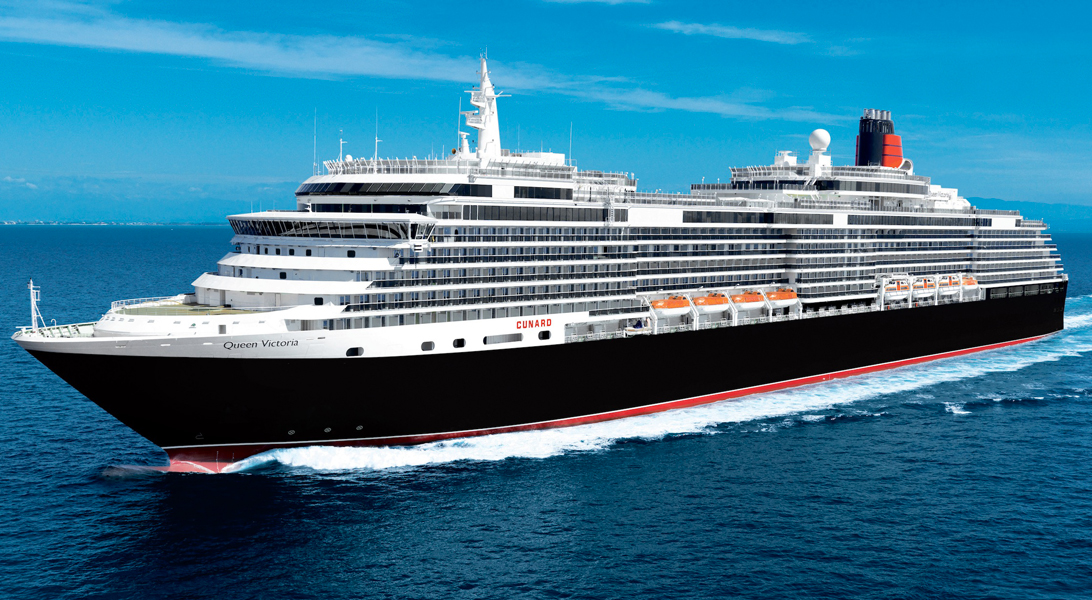












The images shown are for illustration purposes only and may not be an exact representation of what you find on the ship.
The images shown are for illustration purposes only and may not be an exact representation of what you find on the ship.

Our main restaurant invites you to enjoy breakfast, lunch and dinner with a real sense of occasion.
Dining is a highlight of each Cunard voyage and the Britannia Restaurant ensures that it's unforgettable, especially on Gala Evenings. Experience a stylish and vibrant atmosphere and be tempted by freshly prepared dishes which range from twists on traditional favourites to contemporary selections. If you decide to join us here for breakfast or lunch you’ll find it traditional and relaxed, whereas at dinner this glamorous venue really sparkles.
Britannia Club guests will appreciate the more intimate surroundings of this stylish restaurant.
As you’d expect, menus change daily and in addition to the full selection from the Britannia restaurant you can savour a range of enhancements for an extraordinary dining experience.
Guests can now choose to reserve a table at any time of the evening alongside the more traditional early and late seating options.
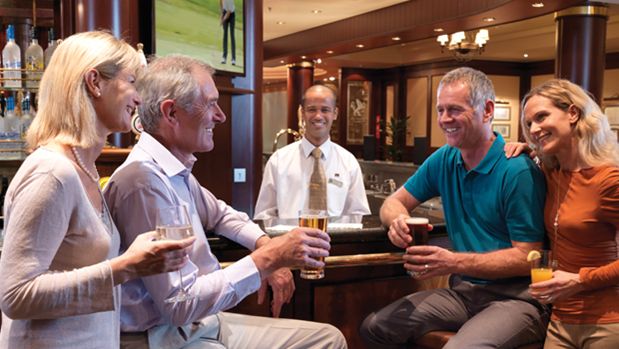
The Golden Lion is an authentic British pub with a great selection of beer and cider. This is complemented by a traditional pub lunch menu with favourites such as cottage pie and fish and chips
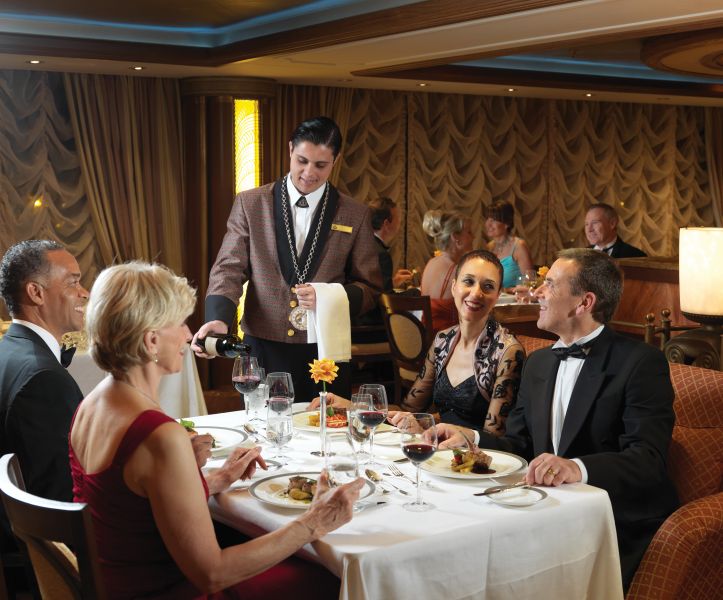
As a Princess Grill guest dining here you’ll appreciate style and elegance, whatever the occasion.
As a guest in our Princess Grill suites you may choose to join us in the elegant Princess Grill for breakfast, lunch or dinner. Whatever the occasion you’ll always feel special with personal and intuitive service. Join us for dinner anytime from 6.30 to 9.00, whenever suits you best.
Choose from dishes such as Goats Cheese Souffle or Yellow Fin Tuna Tartare to start, perhaps followed by Rack of Dartmoor Lamb or Pan Roasted Halibut, all rounded off with a delicious Chocolate Pecan Terrine.
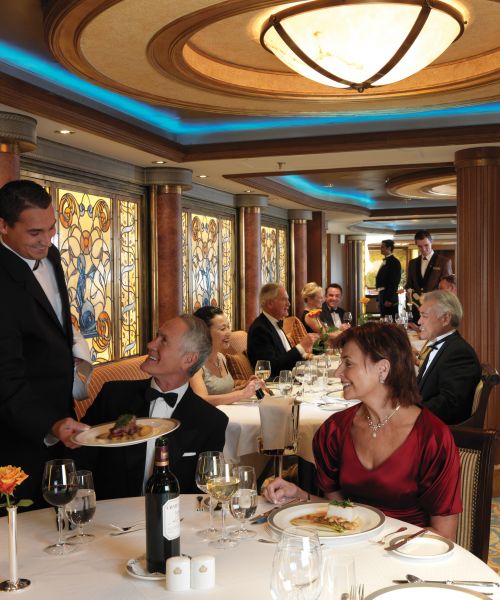
In the beautifully appointed Queens Grill you can savour the ultimate in dining sophistication.
As a guest in our Queens Grill suites you’ll enjoy a remarkable dining experience. Whether it’s for breakfast, lunch or dinner you’ll savour flawless service and impeccably prepared dishes ranging from exquisite contemporary creations to Cunard Classics. Enjoy the daily menu or go A La Carte, you choose. This evening you may relish a Terrine of Kentish Goats Cheese or Devon Crab Cannelloni, followed by Wild Atlantic Turbot or Onley Grounds Chateaubriand, rounded off with Grand Marnier Souffle.
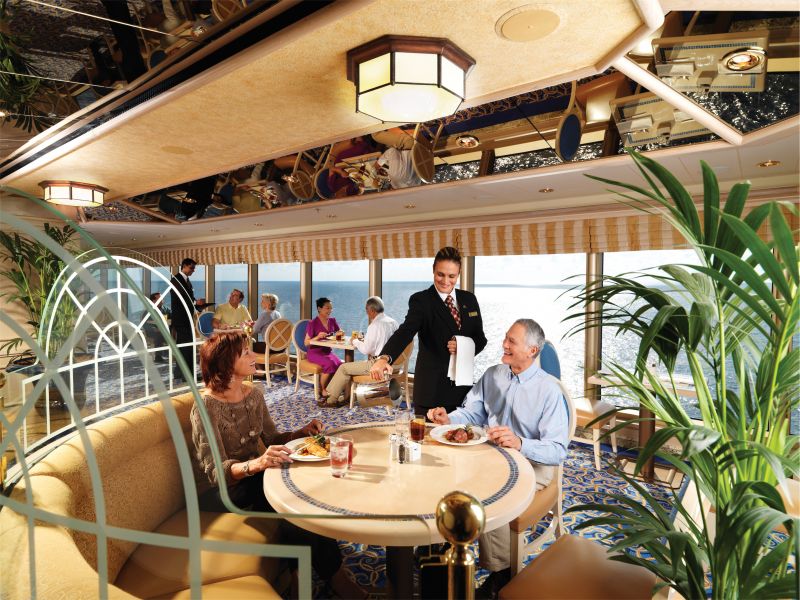
Should you prefer a club sandwich or a light bite in the afternoon head for the Lido restaurant where buffet dining is available throughout the day. By evening it transforms into one of Cunard's regional venues: Asado is a South American Grill; Jasmine serves up exquisite Asian cuisine; while Aztec tempts you with interpretations of Mexican classics.

The Verandah is Queen Victoria's formal alternative dining venue and is your invitation to savour contemporary French cuisine that uses traditional ingredients sourced directly from France.
The images shown are for illustration purposes only and may not be an exact representation of what you find on the ship.
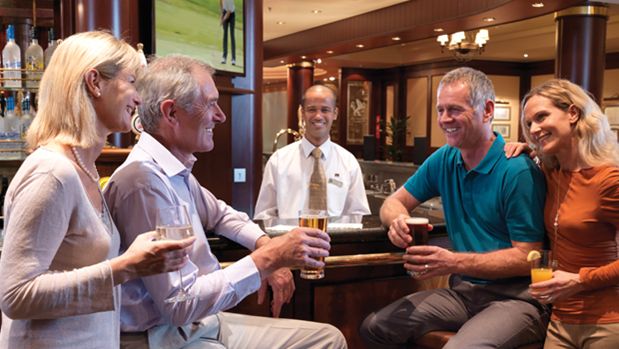
Enjoy the unique atmosphere of a real pub with great beers, scrumptious lunches, live sport and pub games.
A popular venue on each member of the Cunard fleet, the Golden Lion is a warm, inviting space for a daytime brew, a hearty lunch, or an evening pub quiz.
Choose a pub classic from the food menu - included at no extra cost as one of your dining options - and wash it down with one of the Golden Lion's thirst-quenching range of ales, lagers and ciders, including a range of drinks exclusive to Cunard.
Relax in our comfortable booths with your chosen beverage and watch the world sail by. Challenge yourself and your travelling companions with a game of darts, join one of our regular pub quizzes or visit for an after-dinner drink and karaoke.
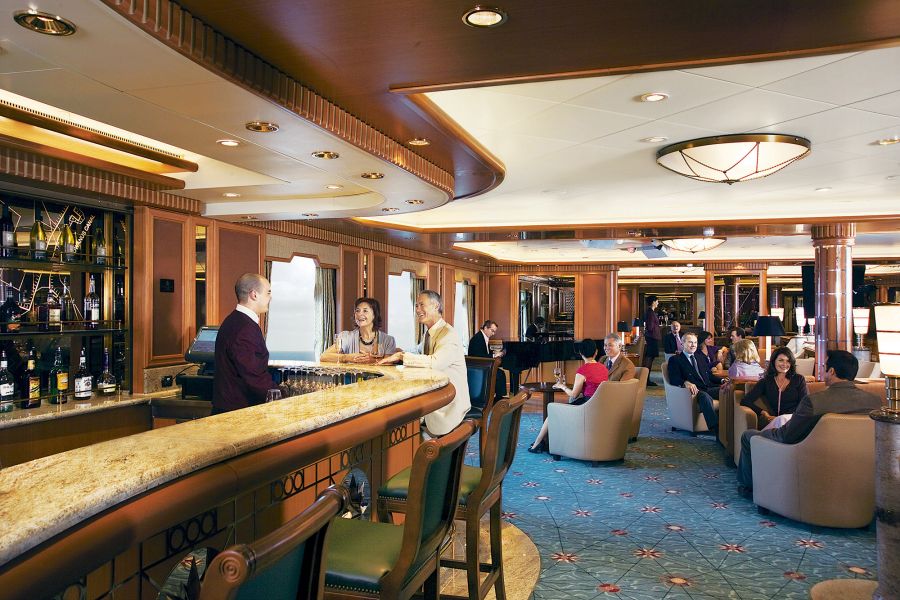
Churchill's Cigar Lounge is located on deck 10.
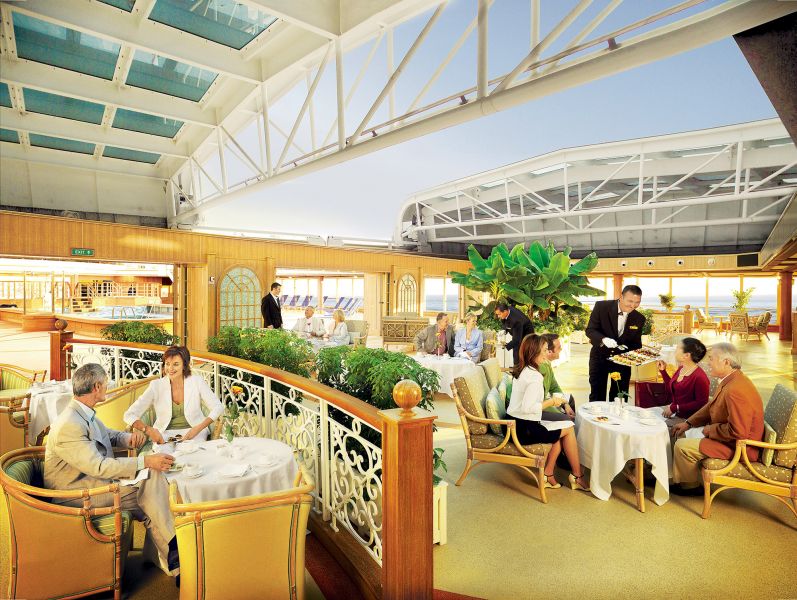
You'll find this airy lounge is flooded with daylight and is always relaxing at any time of day.
On board Queen Victoria, close to the pool and Lido buffet, this is the place to experience a more informal atmosphere until late in the evening. Floor-to-ceiling windows allow sweeping views from this comfortable and relaxing venue.
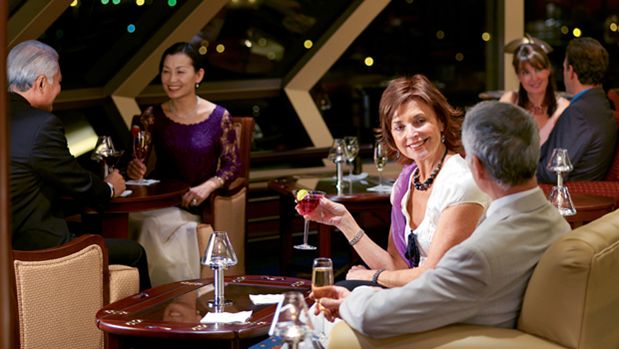
Succumb to the charms of this magical bar, which takes pride of place overlooking the bow of the ship.
Savour the view of the world as it unfurls across the bow from this stunning location and discover just why the Commodore Club is such a remarkable venue. Taking inspiration from our Cunard Commodores who have expertly steered the fleet, join us here to enjoy pre dinner cocktails. Admire the sun setting over the sparkling ocean as you relax to the soothing tones of the pianist. Enjoy a delicious signature martini or sample a cocktail inspired by one of our seven most decorated Commodores.
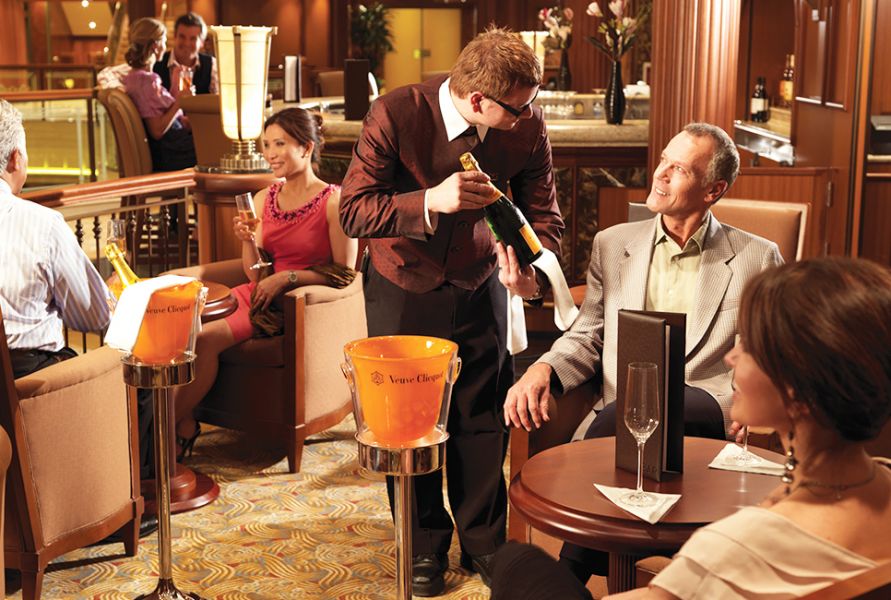
You'll find our elegant Champagne Bar the perfect venue to enjoy delicious premium Champagne.
Cunard is proud to offer guests a comprehensive collection of Laurent-Perrier's premium champagnes across the fleet.
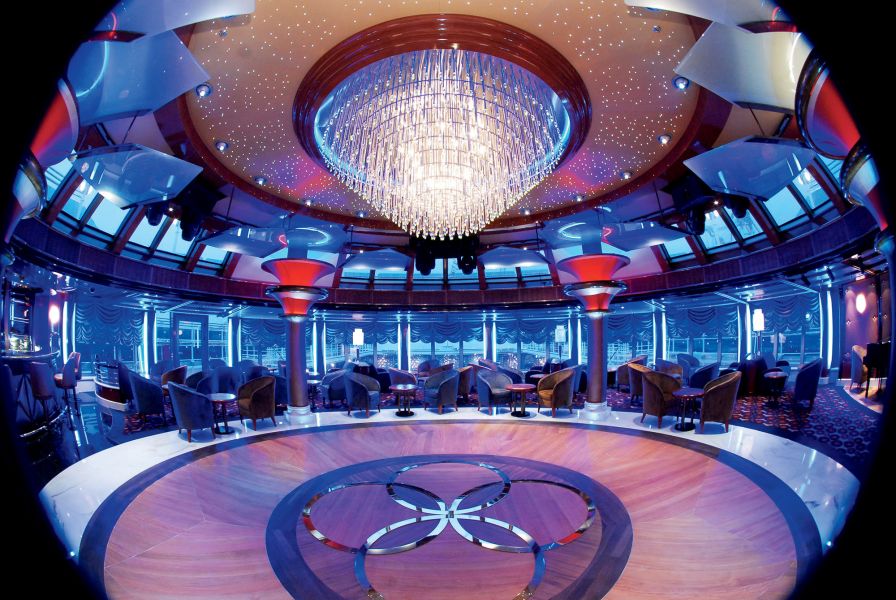
By day admire the expansive panoramic views that stretch from horizon to horizon, and by night dance to the beat of the big band and DJ. All set under the splendid glass-domed roof of this stunning contemporary nightclub.
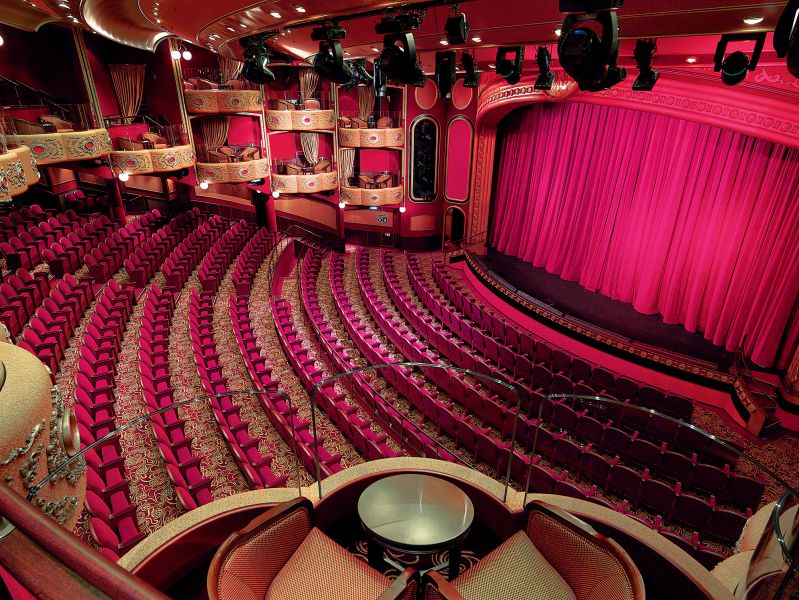
Experience the thrill of a vibrant music and dance extravaganza in our full sized theatres.
You'll find our elegant Royal Court Theatres as impressive as any in the West End or Broadway and they're the perfect setting for you to enjoy invigorating, high-tech dance productions. We're constantly introducing new shows performed by our highly talented Royal Cunard Singers and Dancers. Popular recent productions including the cutting-edge dance shows 'La Danza' and 'Rhythm of the Night,' which takes audiences on a magical journey through the sights and sounds of Latin America.
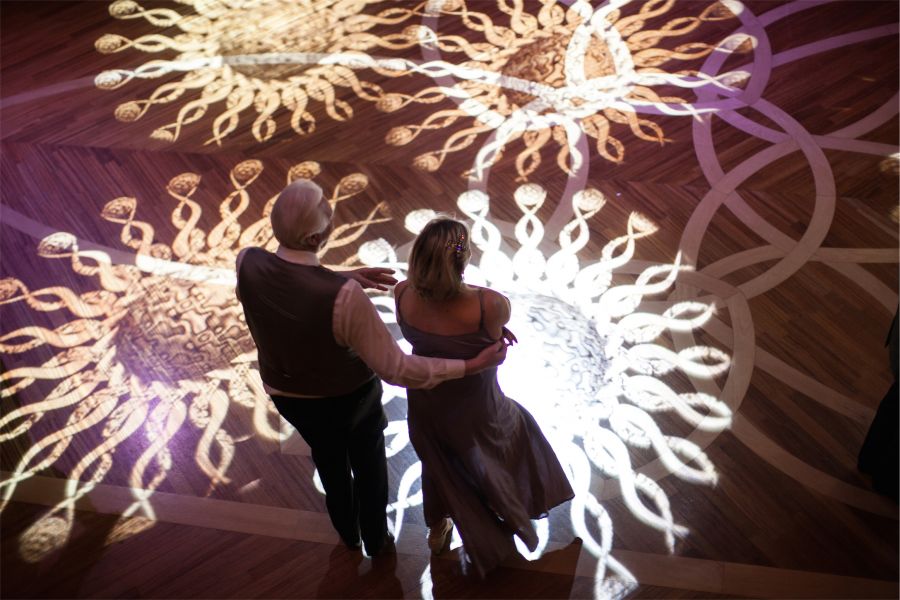
Experience the grandeur of the largest ballroom at sea and the social hub of the ship.
You'll soon discover that it’s the elegant Queens Room which plays centre stage to so much of your social calendar and is frequently a hub of activity. By day this stunning venue hosts dancing classes, fencing, music recitals and our grandest interpretation of Afternoon Tea. When darkness falls join us as the orchestra strikes up for an evening of dancing or simply to enjoy the atmosphere over a cocktail. And it's on Gala Evenings when you'll really love the sparkling sense of occasion here.
The images shown are for illustration purposes only and may not be an exact representation of what you find on the ship.

Teenagers 13 to 17 will have a great time with the sports, discos and games we run around the ship.
Teens in your party will have a whale of a time in this dedicated club for 13 to 17 year-olds. They can enjoy deck sports, discos, gaming consoles, quizzes and much more - ensuring an action-packed holiday. They'll also appreciate the special Teen Zone area where they can challenge each other to the latest video games as well as the table tennis tournaments and team games we organise. Note that the exact age groupings will depend on the number of children travelling on any particular voyage.

Enjoy your holiday even more, knowing that your little ones have a safe place to sleep each evening.
There's a great sense of freedom to be had when you can enjoy drinks, dinner or a show knowing that your little ones are sleeping soundly. Available on a first come first served basis, our free of charge Night Nursery equips you with a pager so we can contact you if need be or, if you let us know your plans, we'll come and find you. For that extra peace of mind professional childminders are on hand. Suitable for children aged 6 to 23 months and open from 6pm to 11pm.
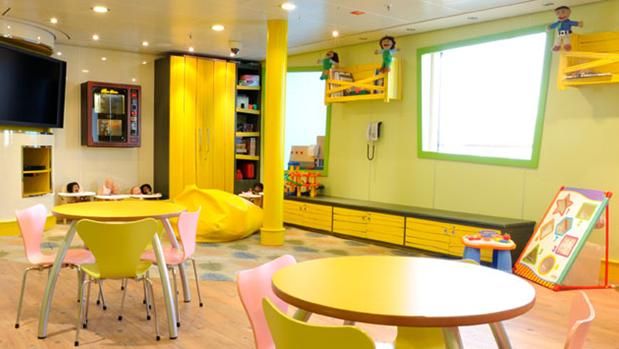
Children aged 2 to 7 will love the activities and themed days in this supervised haven.
The Play Zone is a fully supervised play area which younger members of your family will just love. They're sure to have a fun-filled holiday with the structured activities provided by our fully trained Youth Team - including themed days, arts and crafts, games, books, puzzles, toys and computer games. There's even a sheltered outdoor play area with a range of play equipment such as cars and tricycles. Infants from 6 months to 23 months are welcome to join in the fun, with parental supervision.
The images shown are for illustration purposes only and may not be an exact representation of what you find on the ship.
| 28 nights aboard the Queen Victoria | |||
| Choose FREE on-board spend, coach transfers or car parking (Cunard Fares only) | |||
| Complimentary daily afternoon tea | |||
| Evening entertainment & Broadway style shows | |||
| Upgrade to the Grills Experience | |||
| Tea, coffee, fruit juice is available 24 hours | |||
| 24-hour room service | |||
| Port Taxes and Fees | |||
 | ABTA and ATOL Protection* | ||
Date 12th May 2025 |
Nts 28 |
Please Call for Availability |
Date 12th May 2025 |
Nts 28 |
Please Call for Availability |
| Interior staterooms |  | ||
| LC | Single Inside |  | |
| GA | Deluxe Inside |  | |
| GB | Deluxe Inside |  | |
| GC | Deluxe Inside |  | |
| IA | Standard Inside |  | |
| ID | Standard Inside |  | |
| IE | Standard Inside |  | |
| IF | Standard Inside |  | |
| Oceanview staterooms |  | ||
| KC | Single Oceanview |  | |
| EB | Oceanview |  | |
| EC | Oceanview |  | |
| EF | Oceanview |  | |
| FB | Oceanview |  | |
| FC | Oceanview |  | |
| Balcony staterooms |  | ||
| A1 | Club Balcony |  | |
| A2 | Club Balcony |  | |
| BA | Balcony |  | |
| BB | Balcony |  | |
| BC | Balcony |  | |
| BD | Balcony |  | |
| BE | Balcony |  | |
| BF | Balcony |  | |
| CA | Balcony |  | |
| CB | Balcony |  | |
| Suite staterooms |  | ||
| P1 | Princess Suite |  | |
| P2 | Princess Suite |  | |
| Q1 | Grand Suite |  | |
| Q2 | Master Suite |  | |
| Q3 | Penthouse |  | |
| Q4 | Penthouse |  | |
| Q5 | Queens Suite |  | |
| Q6 | Queens Suite |  | |
Cunard Fare Benefits
Choice of stateroom ~ First priority dining ~ First priority upgrades ~ Choice of on-board spending money*, car parking* or return coach travel* ~ Low Deposit ~ Flexibility to change your booking ~ Complimentary shuttle buses in port (where available). T&C’s apply
*Not available on cruises less than 5 nights
| Interior staterooms |  | ||
| LC | Single Inside |  | |
| LC | Single Inside |  | |
| LC | Single Inside |  | |
| GA | Deluxe Inside |  | |
| GA | Deluxe Inside |  | |
| GA | Deluxe Inside |  | |
| GB | Deluxe Inside |  | |
| GB | Deluxe Inside |  | |
| GB | Deluxe Inside |  | |
| GC | Deluxe Inside |  | |
| GC | Deluxe Inside |  | |
| GC | Deluxe Inside |  | |
| IA | Standard Inside |  | |
| IA | Standard Inside |  | |
| IA | Standard Inside |  | |
| ID | Standard Inside |  | |
| ID | Standard Inside |  | |
| ID | Standard Inside |  | |
| IE | Standard Inside |  | |
| IE | Standard Inside |  | |
| IE | Standard Inside |  | |
| IF | Standard Inside |  | |
| IF | Standard Inside |  | |
| IF | Standard Inside |  | |
| Oceanview staterooms |  | ||
| KC | Single Oceanview |  | |
| KC | Single Oceanview |  | |
| KC | Single Oceanview |  | |
| EB | Oceanview |  | |
| EB | Oceanview |  | |
| EB | Oceanview |  | |
| EC | Oceanview |  | |
| EC | Oceanview |  | |
| EC | Oceanview |  | |
| EF | Oceanview |  | |
| EF | Oceanview |  | |
| EF | Oceanview |  | |
| FB | Oceanview |  | |
| FB | Oceanview |  | |
| FB | Oceanview |  | |
| FC | Oceanview |  | |
| FC | Oceanview |  | |
| FC | Oceanview |  | |
| Balcony staterooms |  | ||
| A1 | Club Balcony |  | |
| A1 | Club Balcony |  | |
| A1 | Club Balcony |  | |
| A2 | Club Balcony |  | |
| A2 | Club Balcony |  | |
| A2 | Club Balcony |  | |
| BA | Balcony |  | |
| BA | Balcony |  | |
| BA | Balcony |  | |
| BB | Balcony |  | |
| BB | Balcony |  | |
| BB | Balcony |  | |
| BC | Balcony |  | |
| BC | Balcony |  | |
| BC | Balcony |  | |
| BD | Balcony |  | |
| BD | Balcony |  | |
| BD | Balcony |  | |
| BE | Balcony |  | |
| BE | Balcony |  | |
| BE | Balcony |  | |
| BF | Balcony |  | |
| BF | Balcony |  | |
| BF | Balcony |  | |
| CA | Balcony |  | |
| CA | Balcony |  | |
| CA | Balcony |  | |
| CB | Balcony |  | |
| CB | Balcony |  | |
| CB | Balcony |  | |
| Suite staterooms |  | ||
| P1 | Princess Suite |  | |
| P1 | Princess Suite |  | |
| P1 | Princess Suite |  | |
| P2 | Princess Suite |  | |
| P2 | Princess Suite |  | |
| P2 | Princess Suite |  | |
| Q1 | Grand Suite |  | |
| Q1 | Grand Suite |  | |
| Q1 | Grand Suite |  | |
| Q2 | Master Suite |  | |
| Q2 | Master Suite |  | |
| Q2 | Master Suite |  | |
| Q3 | Penthouse |  | |
| Q3 | Penthouse |  | |
| Q3 | Penthouse |  | |
| Q4 | Penthouse |  | |
| Q4 | Penthouse |  | |
| Q4 | Penthouse |  | |
| Q5 | Queens Suite |  | |
| Q5 | Queens Suite |  | |
| Q5 | Queens Suite |  | |
| Q6 | Queens Suite |  | |
| Q6 | Queens Suite |  | |
| Q6 | Queens Suite |  | |
Fusion Cruises when selling travel arrangements is a trading name of The Midcounties Co-operative Ltd. Fusion Cruises is an Accredited Body Member of Midcounties Co-operative Travel Consortium. (ABTA:P6652, ATOL:6053).
Book with Confidence. We are a Member of ABTA which means you have the benefit of ABTA’s assistance and Code of Conduct.
Some of the flights and flight-inclusive holidays on this website are financially protected by the ATOL scheme but ATOL protection does not apply to all holiday and travel services offered on this website. This website will provide you with information on the protection that applies in the case of each holiday and travel service offered before you make your booking. If you do not receive an ATOL Certificate then the booking will not be ATOL protected. If you do receive an ATOL Certificate but all parts of your trip are not listed on it, those parts will not be ATOL protected. Please see our booking conditions for information, or for more information about financial protection and the ATOL Certificate go to: www.caa.co.uk
